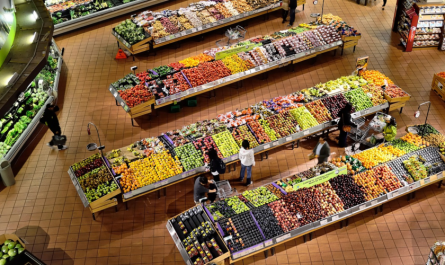The food industry is on the verge of a major revolution, thanks to advancements in lab-grown meat. As concerns about sustainability, animal welfare, and food security continue to rise, lab-grown meat offers a promising solution. This innovative approach to meat production could dramatically transform the way we think about food, both now and in the future. Let’s explore how lab-grown meat will reshape the industry and what it means for consumers, producers, and the environment.
What is Lab-Grown Meat?
Lab-grown meat, also known as cultured or cell-based meat, is real meat that is produced by cultivating animal cells in a controlled environment. Unlike traditional meat, it doesn’t require raising and slaughtering animals. Instead, scientists take a small sample of cells from an animal, typically through a painless process, and then grow these cells in bioreactors that simulate natural conditions.
Why Lab-Grown Meat Matters
Lab-grown meat could significantly reduce the environmental impact of food production. Here’s why it matters:
- Sustainability: Traditional meat production contributes to greenhouse gas emissions, deforestation, and water usage. Lab-grown meat uses significantly less land, water, and energy, making it a far more sustainable option.
- Animal Welfare: By eliminating the need to raise and slaughter animals, lab-grown meat addresses ethical concerns about factory farming and animal cruelty.
- Food Security: With the global population expected to reach 9.7 billion by 2050, lab-grown meat could be a key solution to meeting the world’s growing demand for protein.
How Will Lab-Grown Meat Impact the Food Industry?
Lab-grown meat has the potential to disrupt traditional farming and food production in several ways:
- Reduction in Factory Farming: As lab-grown meat becomes more widely available, the demand for factory-farmed meat may decrease. Large-scale livestock operations might cause less harm to the environment as a result of this.
- New Market Opportunities: The lab-grown meat industry is still in its infancy, but it’s growing rapidly. Companies specializing in cell-based meats are attracting significant investment, and the market is expected to expand quickly in the coming years. This could open up new opportunities for entrepreneurs, scientists, and food innovators.
- Consumer Preferences: As consumers become more aware of the environmental and ethical implications of traditional meat, they are likely to embrace lab-grown alternatives. With advancements in technology, lab-grown meat is expected to match the taste, texture, and nutritional value of conventional meat, making it a viable option for even the most discerning food lovers.
- Cost Reductions: Although lab-grown meat is currently more expensive to produce than traditional meat, costs are expected to decline as technology improves and production scales up. This will make lab-grown meat more affordable and accessible to the general public.
Challenges Facing Lab-Grown Meat
Despite its potential, lab-grown meat faces several challenges:
- Regulatory Approval: In many countries, lab-grown meat is still awaiting regulatory approval. Governments will need to establish clear guidelines to ensure the safety and quality of cell-based meat products before they can hit the market on a large scale.
- Consumer Acceptance: While many people are open to trying lab-grown meat, others may be hesitant due to its unfamiliarity. Changing consumer perceptions will be crucial to the widespread adoption of this new food technology.
- Scaling Production: Producing lab-grown meat on a large scale is complex and requires significant infrastructure. As the technology advances, companies will need to find ways to streamline production and reduce costs to compete with traditional meat producers.
The Environmental Benefits of Lab-Grown Meat
Lab-grown meat offers substantial environmental benefits compared to traditional meat production.
- Lower Carbon Footprint: Cultured meat produces up to 96% fewer greenhouse gas emissions than conventional meat production, making it a key player in the fight against climate change.
- Reduced Water Use: Producing lab-grown meat uses significantly less water than traditional livestock farming, which is essential as water scarcity becomes an increasingly pressing global issue.
- Less Land Required: Since lab-grown meat is produced in labs, it doesn’t require large tracts of land for grazing or growing feed, which could lead to reforestation and other land restoration efforts.
The Future of Lab-Grown Meat
Lab-grown meat is still in its early stages, but it holds immense promise for the future. As technology advances and production becomes more efficient, we can expect to see lab-grown meat on supermarket shelves within the next decade. Here’s what the future could look like:
- Widespread Availability: Lab-grown meat could eventually become as common as traditional meat, offering consumers a sustainable and ethical alternative without sacrificing taste or nutrition.
- New Products: As the technology improves, we could see a range of new products, from lab-grown seafood to cultured dairy and eggs. This could revolutionize the entire food industry, offering a more sustainable approach to producing animal-based products.
- Global Impact: Lab-grown meat could play a significant role in addressing global challenges such as food insecurity, environmental degradation, and animal welfare. By providing a more sustainable and humane alternative to conventional meat production, lab-grown meat could help feed the growing global population while reducing our impact on the planet.
Conclusion
Lab-grown meat has the potential to change the food industry in profound ways. From reducing our environmental footprint to improving animal welfare and ensuring food security, the benefits of lab-grown meat are clear. While challenges remain, the future of lab-grown meat is bright, and it’s only a matter of time before it becomes a staple in our diets. Keep an eye on this exciting development as it continues to reshape the way we think about food production and consumption.







